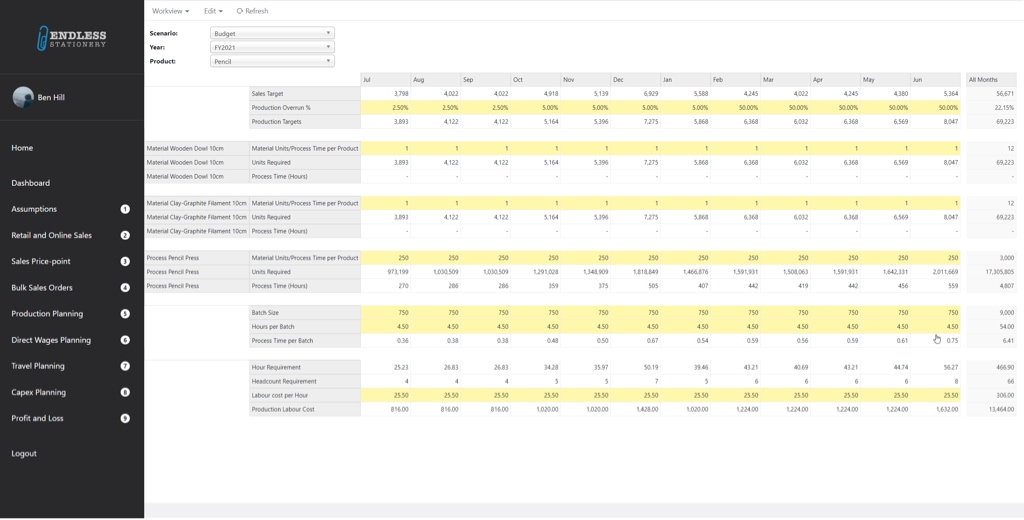What is production planning?
Effective production planning is key to maximising the efficiency of all manufacturing processes in every company. However, an effective production plan is no easy feat to achieve as it requires a complex process involving a multitude of different activities surrounding materials, human resources and equipment - and their timely coordination.
Why should you utilise production plans?
Production plans are incredible tools for a company and, essentially, function as a roadmap for their manufacturing and production processes. A production plan maps out the time and processes of how to match your production to customer demand. An effective production plan provides great clarity and understanding across deep levels of complexity; looking at your production plan should mean you have a simple and clear set of directions towards your production objectives and goals.
Advantages of an effective production plan and schedule include:
- • Improving process flow and reducing labour costs and wasted time.
- • Lowering inventory costs through decreasing excessive work-in-process inventories and safety stock.
- • Ensuring delivery targets of products and services are always met.
- • Optimising allocation of equipment and resources, and increasing capacity of resources.
Strategies to ensure effective production plans:
1. Improve your forecasting
Production plans should start with mapping out questions to gain an understanding of what you need, e.g., what products do you need to make to meet demand? How many products are you going to sell? What and how many materials do you need to stock to make these products? Where are you going to source this material? These are the typical start-up questions for figuring out your production plan. Getting the answers to these questions is a bit more tricky, especially when you are figuring out the optimal sourcing strategy to match raw material stock to changing customer demand.
Using past estimations as a guideline of how much demand to expect can be a good indicator of future market demand and conditions, but it cannot provide a full picture of all the changes that may occur. So, because we rely on forecasts to give us an estimation on how to spend our resources, the accuracy of these forecasts is in turn extremely important to make sure your resources are well-spent. If you want an effective and profitable production line, then improving the accuracy of your forecasts is an essential investment to continuously yield a positive ROI. If you already are using digital data streams to gather information about your production workflows and wider market conditions, it may be valuable to use machine learning solutions or advanced analytics to support your forecasting methods.
By implementing advanced analytics and or machine learning solutions, your forecasts won’t be bound to just past data and estimations, you will be able to dynamically forecast demand and better align your expectations to the reality of the world as it changes.
2. Implement real-time monitoring and reduce risk factors
When you want to ensure that your production plans are effective and in line with the changing reality of the world, you need to be able to record and monitor your processes and data in real-time. To do this you can implement a network of real-time smart sensors into your production chain and track the progress of each product on the production line. In doing so you can go beyond and look at the machine usage to see if it’s running smoothly, if capacity is being fully utilised, and if parts need repairs or maintenance. With real-time monitoring, you can make sure you know the minute that problems start to affect your output and take actions to solve them. You can also see opportunities for growth in your production processes in real-time if you identify areas of improvement. This type of tracking may even be automated to set alerts when something in production isn’t following the plan. This helps you keep plans on track even when you are testing new practices.
Furthermore, real-time monitoring will help you monitor, detail, and record work-site incidents so that you can promptly fix any issues that come up, and create relevant plans to prevent future recurrence. By recording situations where failures occur, you can conduct a failures modes and effects analysis (FMEA). This method lets you understand why potential problems may occur and helps you implement the proper controls or solutions to eliminate or minimise risk.
3. Document your production capacity
A core aspect of production planning is to make the most use of your production capacity and minimise downtime. Constant operation of every resource is naturally not feasible or a healthy process for machinery or human resources but having long stretches of downtime is costly and inefficient. Ideally, you want balanced running schedules that avoid having your machines and human resources being idle for long periods of time, but factor in sustainable and healthy breaks. So how do planners ensure that balance and minimise the loss of value from downtime? The first step is to get a clear picture of what your production capacity is.
Knowing your production capacity is a simple concept at first glance, but it can contain many complex layers. Different products have different methods of production and different requirements from the gathering of the raw materials to the end-product. A flow shop environment, for example, would have a set order of operations and be categorised, scheduled and planned out, whilst a job shop environment holds no set order of operations. In a job shop environment, different product flows are used for different products - because of this factor of interchangeability within the production floor it can be tricky to balance and understand your production capacity. Because of this complexity, it is important to map out your production processes step by step to help determine your actual maximum production capacity. Doing this can be as simple as finding and timing the bottleneck processes in your production or as complicated as digitally mapping out your factory floor and using advanced analytics and algorithms within your operations.
4. Fix your planning silos
Planning silos are gaps in your planning where processes are being hindered, or value is being lost. To ensure your production planning is effective you have to identify and subsequently work to break down the production silos present in your operations.
In modern manufacturing, finding procurement processes separate from production planning isn’t surprising. This means that even if you have forecasts with pinpoint accuracy, you might end up finding that you are short of the materials on hand to follow through with your planned processes. A good place to start with breaking down your production silos is with increasing operational visibility. This could look like integrating an IT system to centralise your data or utilising digital technologies to record and access your data in real-time. With greater operational visibility comes a more in-depth understanding of where your planning silos are, and how you can fix them.
5. Standardise steps
Standardising steps is also an effective method to get rid of planning silos. One of the most efficient ways to do so, is to first map out your processes in the order of occurrence, then measure the average time it takes to complete the work. This will help you gain a clearer picture of your production steps standards. Some steps may not all happen during a sequence and some may happen at the same time, so take this into account.
Once all processes have been determined, you will get a full picture of the time it takes to complete your entire production process. You can then identify similar or identical areas to each other to create clear standards of time and work involved. Recording documentation will let you create baseline estimations for future activities that are similar, and help speed up your planning process by a significant margin.
6. Efficient communications
Effective production plans are nothing if they are not properly communicated and understood by the relevant parties involved. After deciding on all the criteria you need to begin production, you need to figure out how to properly communicate it.
Normally, production can be planned out with manual processes involving spreadsheets, databases or software – but with rising complexity in data, traditional manual processes become more of a burden than an advantage as a means to communicate plans efficiently.
Furthermore, visual representation is a more effective means of communication to show operation schedules across production floors, and real-time accuracy is key. For this reason, adapting to a real-time integrated platform that can provide a single source of truth can spread out your communications instantly and accurately.
7. Embracing change as a friend, not an enemy
Change is a frightening concept to many. Production planning and production scheduling are especially riddled with spur of the moment changes to orders. Adapting to the fast pace of these changes is difficult, so you must use a system that is fluid and open to adjustment. So, ensure that your production plan has contingency processes in place, as well as a system that can rapidly identify and enact actions that handle sudden changes in production. Seamless tracking and reporting software will go a long way here.
Integrated planning for production
So, to ensure your production plans are effective, you’ve improved your forecasts, implemented real-time monitoring, understood your production capacity alongside getting rid of production silos and standardised your steps. You’ve then proceeded to communicate them and are mindful of adapting to any changes that may be thrown your way.
What else can you do now?
Hopefully, that would mean you have the perfect production plan, and that all of your inventory is optimally allocated to your demand. But, no matter how well you have thought out your production plan and executed it, if you aren’t able to move your goods off the production line efficiently then it doesn’t matter. Because of this, you need to ensure that visibility, silo reduction and data integrations extend to your supply chain in its entirety. This way you can ensure effective and optimised processes for the entirety of your production processes - and not just a single element of it. Fortunately, this can all be made easy with MODLR.
MODLR’s Production Planning Solution
With MODLR, you can connect your plans across the entire organisation's supply chain by establishing a single source of truth. Under this single source of truth, you can simultaneously optimise and integrate your supply and demand planning in real-time. This opens up a cohesive and full picture of your organisation's operations allowing you to capitalise on all opportunities possible to the business, and to quickly fix any silos in your processes. MODLR also swiftly reflects real-time demand changes in your supply production requirements enabling you to easily manage your production plans with one functional manager.

MODLR’s all-in-one integrated planning solution allows you to adjust your processes quickly and easily while getting in-depth analysis and understanding of your production capacity, silos, and standardise your production steps. Finally, with real-time processes and monitoring capabilities, MODLR ensures that your communication is thorough, efficient and secure while allowing changes to be actioned quickly, minimising bottlenecks.
Try out MODLR here with a free account, and see for yourself how the Cloud Platform's production planning solution can help your organisation create seamless production plans.






